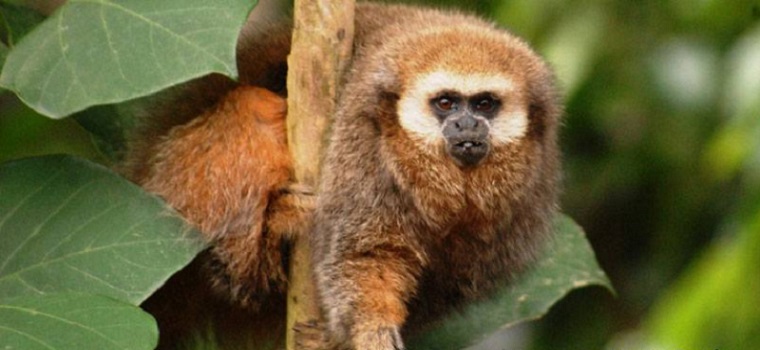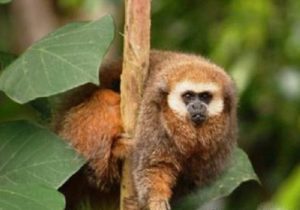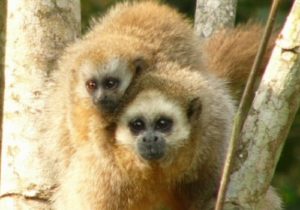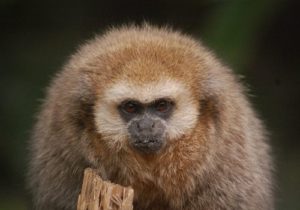
Andean Titi Monkey. Photo credit: Proyecto Mono Tocon
o
o
Interesting Facts
- The Andean Titi Monkey belongs to the genus Callicebus. There are 30 species of titis that belong to this genus.
- The Andean Titi is locally known as “mono tocon” or in the native Awajun language as the “sugkamat”.
- Their tails are longer than their bodies.
Name
- Scientific Name: Callicebus oenanthe
- Common Name: San Martin Titi Monkey, Rio Mayo Titi Monkey, Andean Titi Monkey.

Conservation Status and Population
- The Andean Titi Monkey is listed as Critically Endangered by the IUCN.
- Over the last 25 years its population has decreased by over 80% due to deforestation for agricultural activities and human colonization.
- The number of individuals in the wild is unknown.
- In 2007 Proyecto Mono Tocon was created as a long term project dedicated to study the Andean Titi Monkey.
- Its population is severely fragmented and its trend decreasing due to loss of habitat.
- Titi monkeys are hunt for their meat and used as pets.
Distribution and Habitat
- This species is endemic to the region of Alto and Lower Rio Mayo Valley and Huallaga Central in San Martin, Peru. Its distribution extends to the foothills of the Andes at altitudes of 2,460 to 3,118 feet (750 to 950 meters). See endangered animals of the Andes.
- According a study undertaken by the Proyecto Mono Tocon, at least 60% of its original habitat has been lost. Its current range comprises small fragments of secondary forest.
- Most populations are found isolated and living in highly degraded forests.
- Their preferred habitat is dense forests near sources of water.

Andean Titi Monkey Distribution. Map adapted from IUCN .
Physical Features
- The Andean Titi is a type of New World monkey.
- Titis are small monkeys, they have small furry bodies and long tales which are longer than their body.
- The fur in its body is long and soft with a reddish brown coloration and lighter underside, however there is a high variation in color among individuals. Some Andean Titis show orange, dark brown and all shades in between.
- The color of the face show the most variation among individuals. While some have a white mask surrounding their eyes and muzzle, others have black or brown fur or a mix of colors.
- Males are from 0.98 to 1.48 feet (30 to 45 centimeters) long while females 0.95 to 1.38 feet (29 to 42 centimeters). Males weight from 1.75 to 2.65 lb (800 to 1,200 grams) and females from 1.54 to 2.25 lb (700 to 1,020 grams).
- The length of the tail varies from 1.18 to 1.64 feet (30 to 50 centimeters) in males and from1.18 to 2.1 feet (36 to 64 centimeters) in females.
- Andean Titi Monkey
Behavior
- Titi monkeys are monogamous and live in small family groups of 3 to 7.
- They are more active during they day and spend most of their time on branches of trees grooming each other and looking for food.
- They sleep at night but take midday naps.
- They are very agile and can jump from branch to branch, some call them jumping monkeys.
- Titis are territorial mammals and defend their territory by chasing away intruders and shouting at them.
Reproduction
- Ttis are monogamous, their mating partners are for life unless they die.
- Gestation lasts approximately 5 months. Usually one infant is born and both mother and father rear their young. Nursing last for at least 5 months.
- Titis stay with their family for 2 to 3 years after that they leave in search of a partner.
Taxonomy
- Kingdom: Animalia
- Phylum: Chordata
- Class: Mammalia
- Order: Primates
- Family: Pitheciidae
- Genus: Callicebus
- Species: Callicebus oenanthe
Diet
- Its diet consists mostly of fruits (39%) and insects (45%). They also eat seeds, flowers and leaves.
Life Expectancy
- Andean Titis are expected to live up to 12 years in the wild.
Reference and Further Research
- ITIS Report – Callicebus oenanthe
- Proyecto Mono Tocon
- Living on the edge: Critically Endangered San Martin titi monkeys (Callicebus oenanthe) show a preference for forest boundaries in C.C. Ojos de Agua, Peru. Silvy van Kuijk, MSc Primate Conservation Oxford Brookes University
- IUCN Red List of Threatened Species (Callicebus oenanthe)
- US National Library of Medicine National Institutes of Health
- Conservation International – GIS Risk Assessment and GAP Analysis for the Andean Titi Monkey (Callicebus oenanthe)


